Abstract
Soil moisture can be an important indicator of climate change in humid and semi-arid areas. This indicator can more efficiently propose different public policies related to climate change than just using precipitation and temperature data. Given the above, the objective of this study is to evaluate changes in soil moisture in the state of Pernambuco during the period 1961–2021, using the System of Hydrological Response Units for Pernambuco. In this study, two river basins in the state of Pernambuco that represent the different climatic conditions of the state were chosen. The results show that in the coastal region there is a tendency towards more saturated soils, and in the semi-arid region there is a tendency towards drier soils. With these results, it is possible to conclude that public policy decisions for the economy, environment, and society must consider this vital water balance variable. Leveraging soil moisture and precipitation data makes it possible to differentiate between flood risks and landslide vulnerabilities, particularly in regions characterized by higher levels of rainfall. Monitoring soil water content in humid and semi-arid areas can significantly enhance early warning systems, thereby preventing loss of life and minimizing the socio-economic impacts of such natural events. As such, this study provides a holistic understanding of the relationship between climatic patterns, soil moisture dynamics, and the occurrence of droughts and floods, ultimately contributing to more effective disaster preparedness and response measures in Pernambuco and similar regions.
1. Introduction
A natural disaster is any calamitous occurrence generated by the effects of nature, in general, and then human-driven phenomena that produce great loss of human life or destruction of the natural environment, private property, or public infrastructure. A natural disaster may be caused by weather, climate events, landslides, and other occurrences originating at Earth’s surface [1]. Some types of disasters are often limited to or occur more frequently in specific geographic regions. For example, in Pernambuco, two specific geographic regions have landslides, flooding, or droughts (semi-arid). The rains generate river floods and flash floods, compromising the quality of life of the local population and causing significant damage to the economy in Pernambuco state [2].
From 2001 to 2018, more than 5000 water-related disasters occurred globally, accounting for 73.9% of all natural disasters. These disasters (i.e., floods, storms, landslides, and droughts) caused over 300,000 deaths and USD ~1.7 trillion in economic damage worldwide. Floods and droughts have had especially significant financial repercussions in recent history. In the 20th century, an estimated USD 365 billion was lost worldwide due to approximately 2100 floods and 430 droughts. The 21st century has experienced an increased frequency of water-related disasters and their associated consequences: from 2001 to 2018, around USD 600 billion was lost globally due to more than 2900 floods or 290 drought events [3].
Unfortunately, the frequency and intensity of natural hazards and extreme events has increased over the last century, with reliable data showing a clear increase over the last four decades. The increase has been attributed to numerous factors, including climate change, world population growth, human activities, and ecosystem degradation [4,5]. Climate change has led to an increase in the frequency and intensity of hazardous events, partly related to the trend towards an increase in temperature and the frequency and intensity of precipitation events [3]. Human settlements are increasingly occupying areas of the landscape that are naturally prone to hazards, including floodplains, low-lying coastal areas, and alluvial fans [3]. In addition, changes associated with the landscape’s physical, chemical, and biological characteristics, largely due to human activities (including urbanization and deforestation), have resulted in widespread degradation of ecosystems. This degradation leads to a decrease in the ability of nature and society to recover from a natural hazard [6], thus creating a positive feedback loop that drives an increase in the more significant number of devastating disaster events. Associated ecosystem functions essential for human well-being, including the ability to grow food and supply fresh water, are also degraded [3].
Throughout history, Pernambuco has recorded different problems related to rains and droughts. On the coast, there are many problems with flooding; in the semi-arid region, there are many problems related to severe droughts. In 1975, Recife, the capital of the Pernambuco state, had 80% of the inhabited territory flooded. There were five days of damage— hospitals operated by candlelight and transportation through the neighborhoods was improvised using boats. In 2022, after almost 50 years, a new major disaster occurred in Recife—landslides. Recife is a low-elevation city susceptible to flooding. Pernambuco was the worst tragedy in the last 50 years due to natural disasters. The event resulted in 130 deaths, more than 119,000 homeless, and 44 cities with an emergency decree. In Pernambuco, there is frequent flooding in the coastal region. On the other hand, in a semi-arid region, in 2021, twelve cities of Pernambuco were in an emergency state because of natural disasters and drought. Soil moisture is important for monitoring natural disasters related to droughts and floods.
Fire has been used for many years in Brazil, serving various purposes. However, if mishandled, it can cause fires with immense environmental damage. The Sertão and São Francisco Pernambucano mesoregions are susceptible to fires since the predominant biome is the Caatinga, with a semi-arid climate and low rainfall [7].
Hydrology, as a science, refers to studying the hydrological cycle. This comprises hydrological processes that can be analyzed over time, space, or both together, which, in turn, are quantitatively described by hydrological variables and represented by historical series. Therefore, it is essential to screen historical series to properly assess hydrological processes and their variability to public action policy [8].
The hydrological model Soil Water Assessment Tool (SWAT) is very widespread in Brazil; due to the need for adjustments in the results obtained through modeling and observed data, it is necessary to carry out a calibration. Different studies have been developed to calibrate the swat model to Brazil (e.g., Refs. [9,10,11,12] for the northeast of Brazil, Ref. [13], and for the Pernambuco basins Refs. [13,14,15,16,17,18,19]. The intention was and is to provide a system that can facilitate the monitoring and planning of watersheds. This system is called the SUPer-System of Hydrological Response Units for Pernambuco [19,20,21,22,23].
Soil moisture plays a crucial role in mitigating the impacts of natural disasters, particularly in water-related hazards such as floods and droughts. Understanding and effectively managing soil moisture levels can contribute significantly to disaster risk reduction in the following ways: flood management, drought resilience, landslide prevention, water supply management, and ecosystem health. Therefore, studying and monitoring soil moisture is crucial for better natural resource management, water resources, and mitigating the impacts of climate change. This study aims to relate dry and rainy years with soil moisture in the basins of Pernambuco and to show the impacts of natural disasters that cause droughts and floods in Pernambuco.
2. Materials and Methods
In this study, we selected two basins for analysis. The first, Capibaribe, is a wetland basin that covers part of the capital, Recife. The Capibaribe basin has an area of 7536.65 km2. The second, Terra Nova, has 4909.09 km2, is a semi-arid basin that receives water from the São Francisco River through the PISF-São Francisco Integration Project, Figure 1. Hence, these two basins were chosen to be presented here.
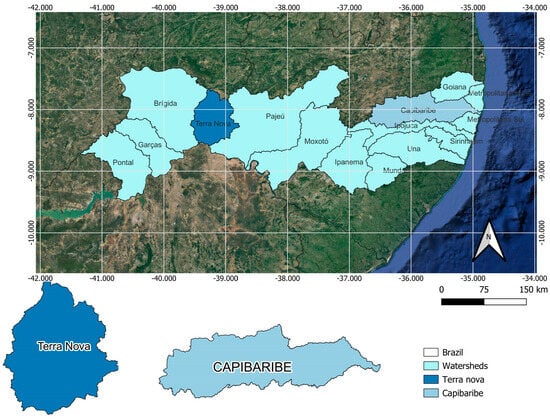
Figure 1.
Localization of the basins Capibaribe (cyan) and Terra Nova (blue), Pernambuco, Brazil.
This study used the SUPer system (System of Hydrological Response Units for Pernambuco), https://super.hawqs.tamu.edu/ (accessed on 3 April 2024). SUPer is a simulation model for the quantification and quality of water in the basin. More detail for SUPer can see in [16,19,23,24].
The methodological basis of SUPer is the Soil and Water Assessment Tool (SWAT), accessible for free at http://swat.tamu.edu (accessed on 3 April 2024). SUPer has been used to simulate numerous basins in the state of Pernambuco for soil and water resource assessments. SUPer is an efficient model that simulates various watershed processes for a defined recording period. SUPer allows researchers to estimate soil moisture in spatial and temporal detail. Thus, SUPer is believed to be very useful in indicating disasters that have a good relationship with the water balance and soil moisture.
In SUPer there are several variables of the hydrological and environmental cycle. This study shows the calibration of the SWAT model for the Capibaribe and Terra Nova basins included in SUPer. In SUPer, the model was run on a daily scale, the setup/warm-up was 2 years, and the SWAT model version was SWAT2012. The SUPer project in the Capibaribe basin has 53 subbasins and 253 Hydrology Response Units (HRU) and Terra Nova basin has subbasins 32 and 174 HRUs.
The data used in this study are soil water (SW) and precipitation of the period (PRECIP). The SWAT necessitates observed data on four fundamental components: terrain, climate, soils, and land use and cover. Terrain data were sourced from EMBRAPA Relief, which provides corrected products derived from the NASA SRTM mission, offering spatial relief data with a resolution of 90 m. Climate data, spanning from 1961 to 2021, were obtained from the INMET database, specifically from the Floresta station in Pernambuco, encompassing various meteorological parameters. Soil spatial characteristics were acquired from two databases: the Agroecological Zoning of the State of Pernambuco (ZAPE) for soil mapping and EMBRAPA Soils for physical–chemical measurements of soil types. Initial land use and cover data were obtained from Landsat TM 5, ETM+/Landsat 7, and OLI/Landsat 8 satellite images for the years 1975–2013. All collected data were formatted for input into the SWAT model, and the project setup was facilitated using the ArcSWAT tool within the ArcGIS software version 2010. Subsequently, the SWAT model was calibrated using SWAT-CUP software version 2012, integrating outputs with calibration algorithms, including SUFI2. Model performance was evaluated using statistical methods such as the Nash–Sutcliffe efficiency coefficient. Following calibration, the model was deployed on the SUPer-System of Hydrological Response Units for Pernambuco, available at https://super.hawqs.tamu.edu/ (accessed on 12 May 2023). The SUPer system, based on SWAT methodology, serves as a simulation model for water quantity and quality assessments in basins. It continuously simulates watershed processes, enabling soil moisture estimation in spatial and temporal detail, thereby aiding in disaster prediction related to water balance and soil moisture.
2.1. Calibration and Validation of Model Results
The methods adopted for validation and calibration of the model were p-factor, r-factor, r2 and r, NS, and PBIAS. A detailed explanation of the calibration and validation criteria: The p-factor measures the ratio of the predicted variability to the observed variability. It is calculated by dividing the predicted values’ standard deviation by the observed values’ standard deviation. A p-factor close to 1 indicates a good match between predicted and observed variabilities. The r-factor criterion evaluates the ratio of the root mean square error (RMSE) of the predicted values to the standard deviation of the observed values. It measures the spread of predicted values relative to observed values. r2 and r are standard measures of goodness-of-fit, assessing the proportion of the variance in the observed data that is predictable from the model. While r2 represents the coefficient of determination, r is the correlation coefficient between observed and predicted values. NS (Nash–Sutcliffe efficiency) evaluates the relative magnitude of the residual variance compared to the variance of the observed data. It is calculated as 1 minus the ratio of the model’s sum of squared errors to the sum of squared differences between the observed data and its mean. An NS value closer to 1 indicates a better fit of the model to the observed data. PBIAS (Percent Bias) measures the average tendency of the model to overestimate or underestimate the observed values. It is calculated as the percentage difference between the sum of the predicted values and the sum of the observed values, normalized using the sum of the observed values. A PBIAS value close to zero indicates minimal bias in the model predictions. These criteria comprehensively assess the model’s performance in accurately representing observed data and ensuring its reliability for further analysis or application.
More detailed information about SUPer can see in [25]. The parameters used in model calibration for the Capibaribe basin are as follows: R-CN2.mgt 0.06; V_ALPHA_BF.gw was 0.1; V_ESCo.hru was 0.6; V_EPSO.hru was 0.56; V_CANMX.hru was 48.35; R_SOL_AWC(…).sol was 0.15; R_SOL_K(…).sol was 0.18; R_SOL_Z(…).sol was 0.06; V_GW_DELAY.g was 5.1; V_GW_REVAP.gwGroundwater “revap” coefficient was 0.18; 4:V_CH_N2.rteManning’s “n” value for the main channel 0.160; and 17:V_SLSUBBSN.hruAverage slope length (m) was 73.42. The results of the statistical performance of the SWAT model in estimating the streamflow (calibration) are as follows: p-factor was 0.09, r-factor was 0.05, r2 was 0.71, NS was 0.66, and PBIAS was −19.5% (validation 0.09, 0.06, 0.62, 0.55, and 2.5%, respectively) [25].
For the Terra Nova basin, no observed flow data are available. We utilized water elevation data, which were converted into flow data. This assessment is minimal, so several statistical procedures were conducted to validate the data estimated using the SWAT for the Terra Nova basin. After converting the water elevation data into flow data, they were compared with the data estimated using the SWAT. To validate the results, Pearson’s correlation coefficient was employed. Additionally, descriptive statistics of the observed and calculated data were evaluated, including the calculation of percentiles. This evaluation aimed to validate the estimated data across various percentiles, including 10, 20, 30, 40, 50, 60, 70, 80, and 90. Following the computation of percentiles, Pearson’s correlation was once again performed. The goal was to demonstrate that the estimated data maintain a strong relationship with the observed flows in the Terra Nova basin.
2.2. Scenery
- 1-
- Actual;
- 2-
- Semi-arid, decrease 15% rainfall, and increase 2 degrees Celius in temperature (climate change);
- 3-
- Umid region, increase 17% rainfall, and increase 2 degrees Celsius in temperature.
The two scenarios were adopted according to the IPCC (Intergovernmental Panel on Climate Change) reports, which indicate climate change trends in different regions worldwide. According to these reports, a decrease in precipitation in semi-arid regions and increased precipitation in humid areas are expected due to global climate change. Therefore, the second scenario, which simulates a 15% reduction in rainfall in the semi-arid regions and a 2 °C increase in temperature, reflects the projections of reduced precipitation for these arid or semi-arid regions. On the other hand, the third scenario, which represents a 17% increase in rainfall in a humid region and a 2 °C increase in temperature, aligns with the projections of increased precipitation in already humid areas. Thus, these scenarios were selected to explore the potential impacts of climate change on extreme weather events, such as floods and droughts, in different regions in Brazil. Additionally, these simulations followed studies by [20,21] that developed a model for the state of Pernambuco on the impacts of precipitation due to increased CO2 in the atmosphere. To contribute to the prognosis of these impacts, the study developed a model that forecasts or creates future scenarios for the state of Pernambuco. For this purpose, the autoregressive method of moving averages, ARIMA, was used. The model adjustment was performed using the normalized Bayesian information criterion function. The results of the developed model showed a good fit. Considering the increase in CO2 in the atmosphere, the model projects a decreasing trend in precipitation for the western part of the state of Pernambuco of approximately 15% below the historical average by 2027. The model projected rainfall above the historical average for the Agreste and the coast of Pernambuco, approximately 17%, by 2027. It is essential to highlight that these increases or decreases in precipitation are already tangible in the current reality.
The innovation of the scenarios adopted in this study is enhanced by integrating the findings of [21] whose work focuses on the impacts of climate change on precipitation, specifically in Pernambuco. By incorporating the results of this pioneering research, our scenarios attain a new level of relevance and accuracy.
The studies by [21] represent a significant milestone in understanding the effects of atmospheric CO2 increase on precipitation distribution at regional scales. These researchers accurately projected future precipitation trends in different parts of Pernambuco by developing an advanced model based on the autoregressive integrated moving average (ARIMA) method.
The integration of these projections into the formulation of scenarios in this study not only enhances the credibility of the simulations but also provides a solid foundation for exploring the potential impacts of climate change on different regions in Brazil. Considering the results of [21], our scenarios can capture specific regional nuances and offer a more precise representation of potential changes in precipitation distribution in response to climate change.
Therefore, the innovation of the scenarios in this study lies not only in the careful selection of simulated climatic conditions but also in the integration of cutting-edge research data and projections, such as those provided by the work of [21] This holistic and collaborative approach raises the sophistication of climate impact analyses, providing valuable information for water resource management and adaptive climate planning in Pernambuco and beyond.
2.3. Soil Water (mm) or Soil Moisture (mm)
“Soil water” and “soil moisture” are related terms describing the soil’s water content. However, they refer to slightly different concepts: Soil water refers to the total water content present within the soil, including all forms of water such as liquid water, vapor, and ice. It encompasses the entire range of water within the soil, including both the water that is readily available for plant uptake (plant-available water) and water that is held tightly by soil particles (unavailable water). Soil moisture is a more specific term that typically refers to the water held in the soil pores or interstitial spaces in liquid water. It represents the water that is readily available to plants for uptake through their roots, as well as the water that contributes to soil infiltration, percolation, and groundwater recharge. Soil moisture is often expressed as a percentage or fraction of the soil volume that is filled with water. In summary, while both terms refer to water content within the soil, “soil water” encompasses all forms of water in the soil, whereas “soil moisture” specifically refers to the liquid water content available for various soil processes, including plant growth.
The SWAT (Soil and Water Assessment Tool) model calculates soil moisture by considering various variables and hydrological processes. Precipitation, evapotranspiration, infiltration, surface runoff, and groundwater flow influence soil moisture. SWAT uses a water-balance-based approach to calculate soil moisture. This involves comparing water inputs into the soil (such as precipitation and irrigation) with the outputs of water from the soil (such as evapotranspiration and runoff). The model also considers the soil water storage capacity, which varies according to the physical characteristics of the soil in different areas. SWAT divides the soil profile into discrete layers and calculates soil moisture in each layer over time. These calculations are performed iteratively based on meteorological conditions, soil characteristics, vegetation, and land use practices specified by the user. In summary, soil moisture in the SWAT model is calculated through a dynamic process that considers various inputs and outputs of water in the soil based on meteorological data and local environmental characteristics.
In the SWAT model (Soil and Water Assessment Tool), the abbreviation “SW” stands for soil moisture and is expressed in millimeters. This representation may seem somewhat confusing since millimeters are typically used to measure precipitation or the amount of water entering the soil. However, in the context of SWAT, the soil moisture value in millimeters does not directly refer to the amount of water present in the soil but rather to the amount of water required to saturate the soil to field capacity. Field capacity is the point where the soil is fully saturated with water, meaning all soil porosity is filled with water. Therefore, when the soil moisture (SW) value is expressed in millimeters, it indicates the amount of water needed to saturate the soil to field capacity in a particular soil layer. For example, if the soil moisture (SW) value is 100 mm in a soil layer, it means that it is saturated to field capacity and contains 100 mm of water per unit depth. This representation in millimeters facilitates the interpretation of model results and allows for a direct comparison with precipitation data, which are also often expressed in millimeters.
This study used aerial photography images obtained using a UAV to visualize changes in vegetation and surface temperature in areas with changing conditions in the São Francisco River water diversion project, an area with water entering the hydrological system.
3. Results
3.1. Capibaribe Basin
The calibration and validation develop model for the Capibaribe basin are published in [26].
It is possible to observe important changes in the average annual water balance (Figure 2 and Figure 3). But, is very important to see return flow because is has increased by 27%. It is possible see increase percolation, increase surface runoff, and increase return flow. Consequences are likely to occur, for example, in reservoirs with high volumes.
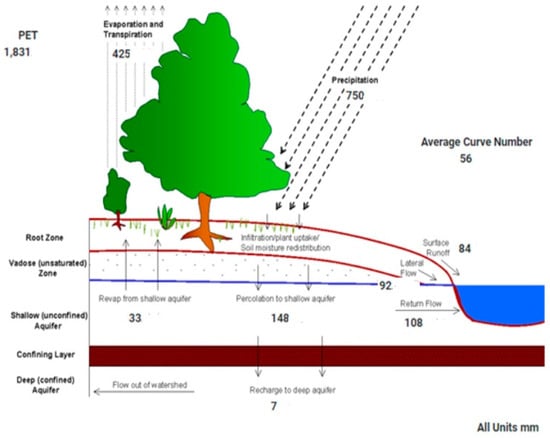
Figure 2.
Average annual water balance—actual situation, Capibaribe basin.

Figure 3.
Average annual water balance—climate change situation, Capibaribe basin.
3.2. Soil Water Capibaribe—Low-SUPer Basin
Climate change is already happening at the local scale. Climate change will increase soil water even more in the future—Figure 4. Soil water will be further impacted in the future. Consequences: increased likelihood of landslides. Using the humidity data, it is possible to predict landslide alerts due to the high humidity content like, for example, in 1975—Figure 5. The capital of Pernambuco has faced two major floods in the last half century: the first in 1966 and the second, and more significant, in July 1975. Between 17 and 18 July 1975, streams and the Capibaribe River rose rapidly and overflowed, flooding entire neighborhoods. About 80% of the city of Recife was underwater. Greater attention during these periods will save lives, more so than only using weather forecasts.
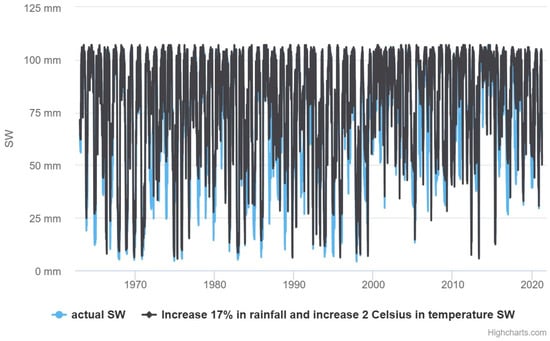
Figure 4.
Daily Soil water (SW) in Capibaribe basin.
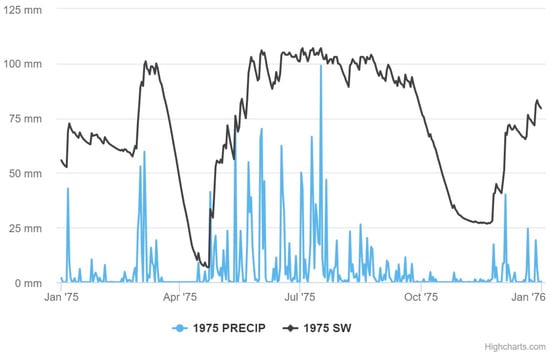
Figure 5.
Daily Soil water (SW) in Capibaribe basin, 1975.
Between 30 July and 1 August 2000 heavy rains punished the state, including the Metropolitan Region of Recife, leaving a total of 22 dead, 100 injured, and more than 60,000 people homeless. Cities were partially destroyed, and the waters that overflowed from the rivers washed away bridges and houses. Almost all year round the soil was saturated—Figure 6.

Figure 6.
Daily Soil water (SW) and precipitation (PRECIP) in Capibaribe basin, 2000.
Between 30 May and 2 June 2005, heavy rains caused flooding in 25 areas of the Agreste, Zona da Mata, and Littoral of Pernambuco, leaving 36 dead and more than 30,000 people homeless. About seven thousand houses were partially or completely destroyed; 40 bridges were damaged; and 11 state highways were hit, seven of which were closed. The water flooded several cities’ central streets, hospitals, schools, and commercial houses, causing enormous material damage. In this period, the SW is shown in Figure 7. Yet, soil water (SW) and precipitation can cause separate flooding risks and landslides.
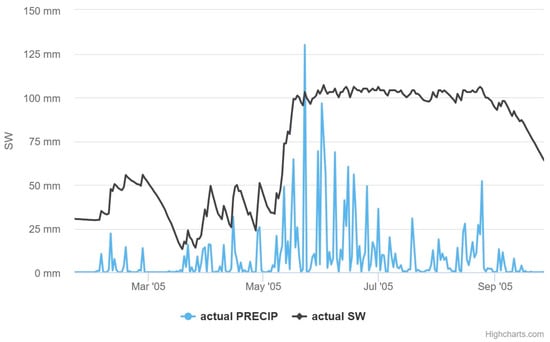
Figure 7.
Daily Soil water (SW) and precipitation (PRECIP) in Capibaribe basin, 2005.
4. Terra Nova Basin
In the semi-arid region of Pernambuco, water availability is limited (Figure 8) and may worsen with climate change (Figure 9). Evaporation and transportation will decrease, potential evapotranspiration (PET) will increase, surface runoff will decrease, lateral flow will decrease, and return flux will decrease with climate change. It is essential to know these results in order to adopt public policies to mitigate the impacts of climate change and natural disasters related to droughts. This basin is undergoing significant transformations in land use and occupation related to development due to water entry into the system through the project to transfer water from the São Francisco River. This development can change the climatic and environmental conditions of the area and needs continuous monitoring. Figure 10 shows an aerial photograph obtained using UAVs and unmanned aerial vehicles of a small area of the Terra Nova watershed where it is possible to perceive spatial transformations related to the water supply that has transformed the vegetation cover and surface temperature conditions. Natural rivers are perennialized in this area and riparian forests and irrigated areas have increased. Changes in vegetation, water conditions, and climate have occurred on a local scale.
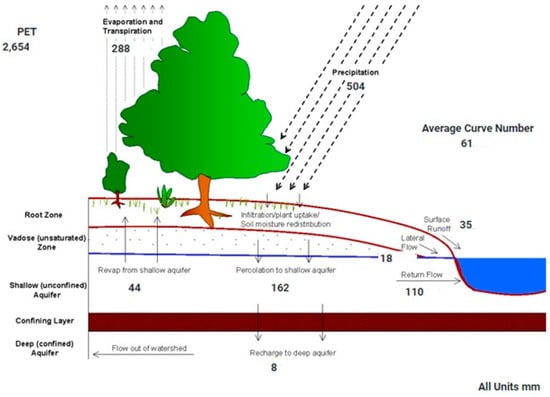
Figure 8.
Average annual water balance—actual situation, Terra Nova Basin.
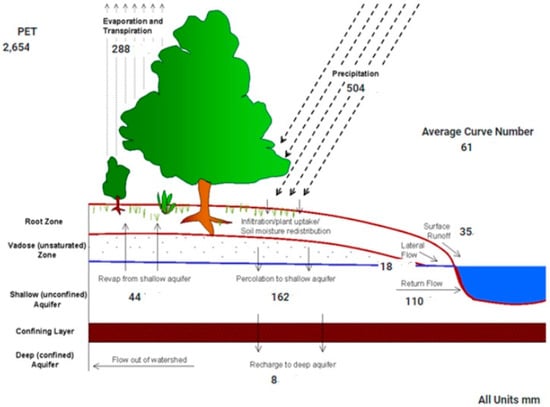
Figure 9.
Average annual water balance—climate change situation, Terra Nova Basin.

Figure 10.
Aerial photographs obtained using Unmanned Aerial Vehicles (UAVs) of a small area of the Terra Nova watershed. (A) Surface temperature image. (B) RGB—Red, Green, Blue image.
It is possible to perceive more extended periods of low soil water—Figure 11. This is very worrying for the survival of the natural ecosystem of the Caatinga area. The vegetation has high vulnerability and low resilience to extreme weather conditions. The Caatinga is the largest continuous SDTF in the Americas, with an open and primarily semi-arid landscape, as seen in many inter-plateau depressions. The Caatinga covers an area of approximately 900,000 km2 and exhibits at least 13 physiognomies ranging from woodlands to sparsely distributed thorny shrubs. Its climate is characterized by high temperatures and low rainfall rates with high intra- and inter-annual variability both in space and time. The rainfall is usually concentrated over 2–4 months of the year, with the possibility of over 25% of the annual precipitation occurring in a single rainfall event [27,28]. A critical result to highlight in this study is the El Niño event of 1998; until 2020, the soil moisture was close to zero.
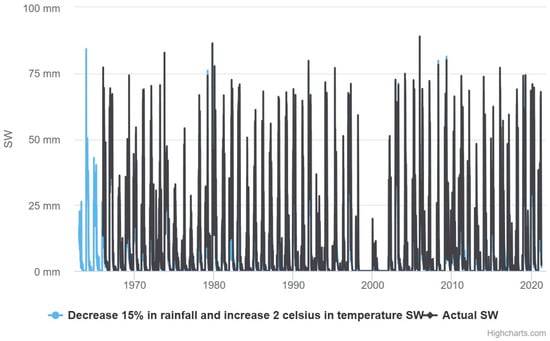
Figure 11.
Daily Soil water (SW) of Terra Nova basin.
There is a greater need to replenish water in the soil for agriculture and ecosystem survival. Reservoirs take a longer time with low volume. The PISF (integration project for the waters of the São Francisco River) project can be a climate change mitigation action (water entering the system). In this region, there is a water supply from the PISF. This is very advantageous. In the semi-arid region, the results of this study showed a decrease in soil moisture and a prolonged increase in days with low soil moisture—Figure 11. The results showed an increase in days with high soil moisture for the humid region.
Calibration and Validation for the Terra Nova Basin
The correlation between the observed and estimated water elevation values was 0.458 at a significance level of 0.01, as shown in Table 1. When percentiles were used, representing a data sampling, the correlation coefficient increased to 0.955 with a significance level of 0.01, Table 2. This indicates that the values estimated using the model closely represent reality. Additionally, this model was also validated by [23] for water quality, where it achieved a validation: RMSE—phosphorus obtained the lowest value, 0.2, while nitrate and dissolved oxygen obtained 0.8 and 1.1, respectively, as shown in the table with the RMSE data obtained for the analyzed years.

Table 1.
Correlations.

Table 2.
Correlations with percentiles.
5. Discussion
According to [29], information on soil moisture is essential for monitoring the intensity of droughts, the beginning of the rainy season, planting dates, and early warnings of productivity losses. In his study, he evaluated drought’s spatial and temporal trends in the Brazilian semi-arid region, combining soil moisture observations from 360 stations, soil moisture in the root zone from a leading land surface model, and a remotely sensed vegetation health index. The soil moisture data set was obtained from the network of stations maintained by the National Center for Monitoring and Alerting of Natural Disasters (Cemaden) in Brazil. Modeled soil moisture was correlated with measurements in the standard period 2015–2018, resulting in an average correlation coefficient of 0.48 across the domain. The standardized soil moisture anomaly (SMA) was calculated for long-term modeled soil moisture. It revealed strong negative values during well-known dry periods in the region, especially during the El Niño years. Public drought assessment policies should consider the combination of several drought indices, including the soil moisture anomaly. The study presented here reinforces the one already studied for the semi-arid region of Brazil by [29], where we indicate the great importance of assessing soil moisture for alerts to natural disasters. In this study, the great advantage when compared to Zeri is the spatial and temporal detailing. As well as the response to the hydrological cycle and the environmental conditions of the area.
According to [26], soil water is vital to sustain semi-arid ecosystems. However, data on soil moisture collected over a long period (e.g., >50 years) is scarce. The SUPer system has provided soil moisture data for 61 years (1961–2021) for Pernambuco. SUPer is based on the Soil Water Assessment Tool (SWAT) hydrological model calibrated using observed flow data. The calibration of the SWAT model for the Terra Nova basin is presented in [30], which performed well with a validation coefficient of determination of 0.67.
Ref. [31] state that landslide-active regions are more likely to experience severe threats to residents under worsening climate change. They claim, that to predict the occurrence of landslides, shallow soil moisture situated at the interface of hydrological processes is one of the critical factors. However, shallow soil moisture data are often scarce in active landslide regions. To overcome serious measurement shortcomings and provide predictions of soil moisture dynamics, the SUPer can be a handy system for such an indication. In the model, the soil’s meteorological conditions and physical properties are considered. With limited field measurements, the model can provide reasonably accurate soil moisture predictions. Hydrological processes interact with precipitation and air temperature variations depending on interconnected soil and water boundary conditions. This demonstrates a strong need for decent forecasting of complex shallow soil moisture dynamics and associated hydrological processes in mountainous regions to deal with climate change for landslide preparedness. This study presents SUPer as an option to warn of natural disasters such as landslides. Thus, like other studies, soil moisture has already been presented as an option for monitoring landslides.
6. Conclusions
In conclusion, despite the absence of direct flow data for the Terra Nova basin, our study successfully transformed water elevation data into flow data to estimate hydrological parameters using the SWAT model. To validate these estimates, we employed rigorous statistical procedures, including Pearson’s correlation coefficient and analysis of descriptive statistics across various percentiles. Our findings indicate a strong relationship between the estimated and observed flows, suggesting that the SWAT model provides reliable estimations even in data-scarce environments like the Terra Nova basin. These results underscore the model’s utility for water resource management and highlight the importance of robust validation techniques in enhancing confidence in hydrological modeling outcomes.
Moving on to the calibration and validation of the SWAT model for the Capibaribe basin, as detailed by [25], these processes have provided valuable information into its performance in estimating streamflow. Using specific parameters and meticulous statistical analysis, the model demonstrated reasonable accuracy in reproducing observed data, as evidenced by the calculated metrics such as p-factor, r-factor, r2, NS, and PBIAS. These results enhance our understanding of hydrological processes within the basin and offer a reliable framework for future water resource management and planning initiatives. By providing a robust tool for predicting streamflow, the calibrated SWAT model equips stakeholders with valuable information to make informed decisions regarding water allocation, flood risk assessment, and environmental conservation efforts. Moreover, the rigorous calibration and validation procedures outlined in the study underscore the importance of utilizing appropriate methodologies and parameterization techniques to ensure the reliability of hydrological models. This study serves as a foundation for further research endeavors to improve the accuracy and applicability of hydrological modeling in similar watersheds, ultimately contributing to sustainable water management practices and resilience against hydrological hazards.
Additionally, this study underscores the potential for changes in soil moisture dynamics, particularly in semi-arid regions such as Pernambuco, Brazil. It reveals that dams experiencing extended periods of low volume are more susceptible to soil moisture alterations than those with prolonged high-volume periods. These findings hold crucial implications for water resource management strategies within the state, offering valuable information into mitigating the impacts of natural disasters like droughts and floods.
Furthermore, leveraging soil moisture and precipitation data makes it possible to differentiate between flood risks and landslide vulnerabilities, particularly in regions characterized by higher levels of rainfall. Moreover, in humid and semi-arid areas, monitoring soil water content can significantly enhance early warning systems, thereby aiding in preventing loss of life and minimizing the socio-economic impacts of such natural events. As such, this study provides a holistic understanding of the relationship between climatic patterns, soil moisture dynamics, and the occurrence of droughts and floods, ultimately contributing to more effective disaster preparedness and response measures in Pernambuco and similar regions.
Regarding the choices of climate change scenarios, the conclusion is that integrating the findings of [21] into the scenarios adopted in this study significantly enhances our understanding of the potential impacts of climate change on precipitation distribution in different regions of Brazil, mainly in Pernambuco. These enhanced scenarios not only increase the credibility of the simulations but also provide a solid foundation for assessing the future effects of climate change on weather extremes, such as floods and droughts.
The study in [21] represents a significant advancement in modeling the effects of atmospheric CO2 increases on regional precipitation, highlighting the importance of considering these factors when designing adaptation and mitigation strategies. By incorporating their findings into our scenarios, we are better equipped to address the challenges of climate change, providing valuable insights for water resource management, urban planning, and climate resilience in Pernambuco and beyond.
Therefore, collaboration among researchers and the application of innovative modeling methods are essential to preparing communities and governments for climate change’s evolving impacts. By adopting a holistic and collaborative approach, we can develop more effective adaptive strategies and ensure a more sustainable future for future generations.
Author Contributions
Conceptualization, J.D.G.; methodology, R.d.Q.M.; software, R.d.Q.M.; validation, J.D.G., R.d.Q.M. and G.G.d.L.; formal analysis, G.G.d.L.; investigation, J.D.G.; resources, J.D.G.; data curation, G.G.d.L.; writing—original draft preparation, J.D.G.; writing—review and editing, J.D.G. and G.G.d.L.; visualization, J.D.G.; supervision, J.D.G.; project administration, J.D.G.; funding acquisition, J.D.G. All authors have read and agreed to the published version of the manuscript.
Funding
This research was funded by CNPq-Conselho Nacional de Desenvolvimento Científico e Tecnológico through 405853/2022-0, INCT-Observatório Nacional de Segurança Hídrica e Gestão Adaptativa (Proc. 406919/2022-4), and BRICS Project (Proc. 442335;2017.2) projects; for the research productivity grants of the first and third authors, Fundação de Amparo à Ciência e Tecnologia do Estado de Pernambuco-FACEPE through the APQ-0392-3.07/22 (FACEPE-FAPESP) projects; and CAPES for the fourth author’s Master’s scholarship. And the APC was funded by CNPq-Conselho Nacional de Desenvolvimento Científico e Tecnológico through 405853/2022-.
Data Availability Statement
All data from this research can be found in the SUPer system, link https://super.hawqs.tamu.edu/#/admin/users (accessed on 3 April 2024).
Acknowledgments
The authors would like to thank CNPq-Conselho Nacional de Desenvolvimento Científico e Tecnológico through 405853/2022-0, INCT-Observatório Nacional de Segurança Hídrica e Gestão Adaptativa (Proc. 406919/2022-4), and BRICS Project (Proc. 442335;2017.2) projects; for the research productivity grants of the first and third authors, Fundação de Amparo à Ciência e Tecnologia do Estado de Pernambuco-FACEPE through the APQ-0392-3.07/22 (FACEPE-FAPESP) projects; and CAPES for the fourth author’s Master’s scholarship.
Conflicts of Interest
The authors declare no conflict of interest.
References
- Metych, M. Natural Disaster. Encyclopedia Britannica. 27 March 2023. Available online: https://www.britannica.com/science/natural-disaster (accessed on 31 July 2023).
- Portela, B.; Alves, G.; da Silva, S.; Lafayette, K. Análise da Vulnerabilidade à Inundação na Bacia Hidrográfica do Rio Sirinhaém, utilizando o Método de Análise Hierárquica. Rev. Bras. Geogr. Física 2023, 16, 1247–1262. [Google Scholar] [CrossRef]
- Saco, P.M.; McDonough, K.R.; Rodriguez, J.; Rivera-Zayas, J.; Sandi, S.G. The role of soils in the regulation of hazardsand extreme events. Phil. Trans. R. Soc. B 2021, 376, 20200178. [Google Scholar] [CrossRef] [PubMed]
- De Guenni, L.B.; Cardoso, M.; Goldammer, J.; Hurtt, G.; Mata, L.J.; Ebi, K.; House, J.; Valdes, J. Regulation of natural hazards: Floods and fires. In Ecosystems and Human Well-Being: Current State and Trends; Norgaard, R., Ed.; Island Press: Washington, DC, USA, 2005; pp. 441–454. [Google Scholar]
- McPhillips, L.E.; Chang, H.; Chester, M.V.; Depietri, Y.; Friedman, E.; Grimm, N.B.; Kominoski, J.S.; McPhearson, T.; Méndez-Lázaro, P.; Rosi, E.J.; et al. Defining extreme events: A cross-disciplinary review. Earth’s Future 2018, 6, 441–455. [Google Scholar] [CrossRef]
- Munang, R.; Thiaw, I.; Alverson, K.; Liu, J.; Han, Z. The role of ecosystem services in climate change adaptation and disaster risk reduction. Curr. Opin. Environ. Sustain. 2013, 5, 47–52. [Google Scholar] [CrossRef]
- Gouveia, J.; Nascimento, C. Identificação Operacional de Áreas com Potencial de Regeneração e/ou Recuperação Vegetal nas Mesorregiões do Sertão e São Francisco Pernambucano. Rev. Bras. Geogr. Física 2023, 16, 1231–1246. [Google Scholar] [CrossRef]
- Kunst Valentini, M.; Beskow, S.; Silva da Silva, M.; Sell, B.; de Mello, C.; Caldeira Beskow, T.; de Morais da Silveira, J. Overview on the historical series of annual maximum streamflows in Brazil: Analysis based on temporal and statistical criteria. Rev. Bras. Geogr. Física 2023, 16, 837–846. [Google Scholar] [CrossRef]
- Castro, R.; Machado, E. Análise De Sensibilidade De Parâmetros Hidrológicos Na Bacia Do Rio Das Pedras—Guarapuava-Pr. Rev. Bras. Geogr. Física 2019, 12, 1746–1756. [Google Scholar] [CrossRef]
- Martins, L.; Martins, W.; de Moraes, J.; Júnior, M.; De Maria, I. Calibração hidrológica do modelo SWAT em bacia hidrográfica caracterizada pela expansão do cultivo da cana-de-açúcar. Rev. Bras. Geogr. Física 2020, 13, 576–594. [Google Scholar] [CrossRef]
- Trentin, R.; Laurent, F.; Robaina, L. Vazão e Balanço Hídrico Relacionado a Mudanças no Uso da Terra em uma Bacia Hidrográfica de Médio Porte no Bioma Pampa do Brasil. Rev. Bras. Geogr. Física 2023, 16, 873–893. [Google Scholar] [CrossRef]
- Paz, Y.; Galvíncio, J.; de Holanda, R.; Srinivasan, R.; Jones, C. Análise de sensibilidade e calibração espacial do modelo SWAT aplicado em uma bacia do litoral pernambucano através de dados climáticos observados e de reanálise (Analysis of sensitivity and calibration of the SWAT model applied in a basin in northeast of Brazil using observed and reanalysis climatic data). Rev. Bras. Geogr. Física 2018, 11, 371–388. [Google Scholar] [CrossRef]
- Lins, F.A.C.; Montenegro, A.A.D.A.; Farias, C.W.L.D.A.; Chagas, A.M.S.D.; Miranda, R.D.Q.; Galvíncio, J.D. Análise Da Dinâmica Temporal Da Evapotranspiração Real Em Uma Bacia Hidrográfica Do Semiárido Através De Modelagem Hidrológica E Sensoriamento Remoto. Irriga 2021, 26, 543–564. [Google Scholar] [CrossRef]
- Paz, Y.M.; Silva, J.F.; Holanda, R.M.; Galvíncio, J.D. Avaliação espacial da produção de sedimentos e estratégias para redução dos processos erosivos em bacia hidrográfica no Nordeste do brasil. Derbyana 2022, 43, e753. [Google Scholar] [CrossRef]
- Brito, P.; Miranda, R.; Morais, Y.C.B.; Costa, V.; Moura, M.; Alves Da Silva, A.S.; Galvincio, J. Avaliação da evapotranspiração estimada pelo MODIS e do balanço hídrico para a bacia do Pontal-Pernambuco. Rev. Bras. Geogr. Física 2021, 14, 2866–2877. [Google Scholar] [CrossRef]
- Farias, C.; Viana, J.; Miranda, R.; Silva, S.; Vasco, G.; Montenegro, S.; Galvíncio, J. Técnica de calibração para modelagem da bacia hidrográfica do Rio São Francisco, Brasil, utilizando o SWAT. Rev. Bras. Geogr. Física 2023, 16, 1621–1628. [Google Scholar] [CrossRef]
- Paz, Y.M.; Silva, J.F.; Holanda, R.M.; Galvíncio, J.D. Planejamento e gestão ambiental de bacias hidrográficas a partir da modelagem hidrossedimentológica e estudo de cenários alternativos de uso e cobertura do solo. Geociências 2022, 41, 675–687. [Google Scholar] [CrossRef]
- Rodrigues, J.; Junqueira, R.; Amorim, J.; Alves, B.; Viola, M. Hydrological modeling in the Sono river basin, environmental protection region of the Jalapão, Brazilian savanna. Rev. Bras. Geogr. Física 2021, 14, 1131–1142. [Google Scholar] [CrossRef]
- Tiburcio, I.; Silveira, N.; dos Santos, T.; Miranda, R.; Galvíncio, J. Balanço Hídrico e Mudanças Climáticas no Semiárido Pernambucano: Aplicabilidade do Sistema de Unidades de Respostas Hidrológicas para Pernambuco (SUPer). Rev. Bras. Geogr. Física 2023, 16, 1657–1670. [Google Scholar] [CrossRef]
- Galvincio, J.D. Impacto do aumento de CO2 nas Precipitações do estado de Pernambuco. Rev. Bras. Geogr. Física 2021, 14, 1828–1839. [Google Scholar] [CrossRef]
- Galvíncio, J.D.; Luz, G.G. Desenvolvimento de Modelo que Estima o Impacto do CO2 Atmosférico nas Precipitações do Estado de Pernambuco, utilizando ARIMA. Rev. Bras. Geogr. Física 2021, 14, 1840–1851. [Google Scholar] [CrossRef]
- Torres, N.S.; Silveira, H.T.; Tiburcio, I.M.; Galvíncio, J.D. Qualidade da Água e Modelagem Hidrológica: Aplicabilidade do Sistema de Unidades de Respostas Hidrológicas para Pernambuco (SUPer). Rev. Bras. De Sensoriamento Remoto 2022, 3, 30–40. [Google Scholar]
- Silveira, N.; Tibúrcio, I.; Soares, G.; Galvíncio, J.; Santos, D.; Montenegro, S. Temporal Analysis of Water Quality for the Nilo Coelho Reservoir, Terra Nova, Pernambuco, Brazil. Water 2023, 15, 2899. [Google Scholar] [CrossRef]
- Luz, G.; Galvíncio, J. Balanço hídrico superficial da bacia hidrográfica do riacho Milagres-PE, utilizando o SUPer. Rev. Bras. Geogr. Física 2022, 15, 1094–1107. [Google Scholar] [CrossRef]
- Farias, C.; Miranda, R.; Viana, J.; Lins, F.; Pereira, J.A.; Ursulino, B.; Montenegro, S.; Galvíncio, J.; Montenegro, A.; Srinivasan, R. Calibration of SWAT Model in the Pernambuco State Watersheds to Support the SUPer System. Rev. Bras. Geogr. Física 2023, 16, 3572–3579. [Google Scholar] [CrossRef]
- Wang, F.; Yang, S.; Wei, Y.; Shi, Q.; Ding, J. Characterizing soil salinity at multiple depth using electromagnetic induction and remote sensing data with random forests: A case study in Tarim River Basin of southern Xinjiang, China. Sci. Total Environ. 2021, 754, 142030. [Google Scholar] [CrossRef]
- Miranda, R.Q.; Nóbrega, R.L.B.; Moura, M.S.B.; Raghavan, S.; Galvíncio, J.D. Realistic and simplified models of plant and leaf area indices for a seasonally dry tropical forest. Int. J. Appl. Earth Obs. Geoinf. 2020, 85, 101992. [Google Scholar] [CrossRef]
- Miranda, R.D.Q.; Galvíncio, J.D.; Morais, Y.C.B.; Moura, M.S.B.; Jones, C.A.; Srinivasan, R. Dry Forest deforestation dynamics in Brazil’s Pontal basin. Rev. Caatinga 2018, 31, 385–395. [Google Scholar] [CrossRef]
- Zeri, M.; Williams, K.; Cunha, A.P.M.A.; Cunha-Zeri, G.; Vianna, M.S.; Blyth, E.M.; Marthews, T.R.; Hayman, G.D.; Costa, J.M.; Marengo, J.A.; et al. Importance of including soil moisture in drought monitoring over the Brazilian semiarid region: An evaluation using the JULES model, in situ observations, and remote sensing. Clim. Resil. Sustain. 2022, 1, e7. [Google Scholar] [CrossRef]
- Luz, G.G.d.; Miranda, R.d.Q.; Galvíncio, J.D. Assessment of Water Availability and Environmental Influence on People’s Lives in a Small Basin in the Hinterland of Pernambuco, Using the SUPer and UAV. Appl. Sci. 2023, 13, 11255. [Google Scholar] [CrossRef]
- Dai, J.Y.; Cheng, S.T. Modeling shallow soil moisture dynamics in mountainous landslide active regions. Front. Environ. Sci. 2022, 10, 913059. [Google Scholar] [CrossRef]
Disclaimer/Publisher’s Note: The statements, opinions and data contained in all publications are solely those of the individual author(s) and contributor(s) and not of MDPI and/or the editor(s). MDPI and/or the editor(s) disclaim responsibility for any injury to people or property resulting from any ideas, methods, instructions or products referred to in the content. |
© 2024 by the authors. Licensee MDPI, Basel, Switzerland. This article is an open access article distributed under the terms and conditions of the Creative Commons Attribution (CC BY) license (https://creativecommons.org/licenses/by/4.0/).